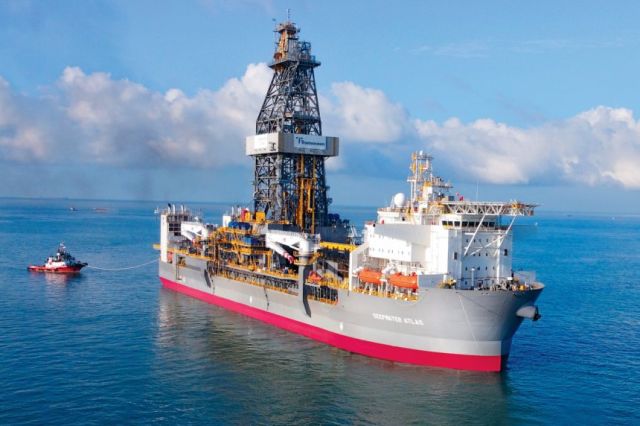
Sixteen years after its discovery, Shenandoah is expected to come online in Q2 2025. (Source: Transocean)
Genesis Energy’s new 105-mile SYNC offshore pipeline is ready, but waiting, to begin transporting oil volumes in the Gulf of Mexico’s Shenandoah project.
The project has been delayed while awaiting the arrival of the Shenandoah floating production system vessel, CEO Grant Sims said.
“The connection of the Shenandoah FPSO to our new SYNC pipeline is expected in the first part of 2025,” Sims said in company’s second quarter earnings report. In the first quarter, Sims said Genesis was awaiting the arrival of the vessel to finalize pipeline and riser connections.
Shenandoah was expected to deliver first oil at the end of 2024, but an accident at the Hyundai Heavy Industries shipyard in South Korea caused the operator, Beacon Offshore Energy, to push the project’s completion date to 2025.
The delayed start-up of Shenandoah, and the shipyard incident in February, are the latest twists for the cutting-edge project that has been in development for a decade-and-a-half and has changed hands numerous times.
Anadarko Petroleum, now owned by Occidental Petroleum, discovered the deepwater field in 2009 with the Shenandoah-1 exploration well in Walker Ridge Block 52. The discovery well reached a total depth of 30,000 ft, finding 300 ft of net oil pay in the Lower Tertiary Wilcox Formation.
Exploration drilling stopped in 2017 when the Shenandoah-6 appraisal well failed to find oil in the eastern portion of the field.
However, Shenandoah is still on track to be one of the first ultra-high-pressure 20,000 psi Lower Tertiary fields to produce hydrocarbons. The Shenandoah delay means Chevron’s Anchor project in Green Canyon area will likely be the first 20,000 psi field to reach first oil this year, if it comes online as planned.
“We continue to expect both the Shenandoah and Salamanca developments to be on-line in the second quarter of 2025,” Sims said.
These Shenandoah and Salamanca developments will provide Genesis with approximately $90 million per year at the contracted take-or-pay level. The two fields could generate $150 million per year when fully operational.
According to Sims, the two developments have 200,000 bbl/d of handling capacity, which will be added to the base throughput volumes.
“These new developments are expected to use less than half of the total capacity of the new SYNC pipeline and only around 50% of the capacity from the CHOPS expansion projects,” Sims said.
This means we have significant additional capacity available for future developments without additional capex for pipeline capacity, Sims added.
However, the first half of the year presented numerous challenges leading to disappointing financial results.
In second-quarter 2024, Genesis reported a net loss of $8.7 million compared to net income of $49.3 million during the same quarter last year.
Genesis reported second quarter cash flow fell by about 33% to $104.7 million, compared to $157.7 million for 2Q 2023, according to the release.
Despite the downturn, Genesis declared cash distributions on their preferred units of $0.9473, which equates to distribution of $21.9 million.
Improvements in the company’s soda ash business and marine transportation segment will not be enough to offset the challenges experienced in the first half of the year.
As a result, the company is adjusting its full year guidance for EBITDA down to $625 million to $650 million, which at the midpoint is 6% below the low end of the original guidance, according to the earnings report.
Recommended Reading
GA Drilling Moves Deep Geothermal Tech Closer to Commercialization
2025-02-19 - The U.S. Department of Energy estimates the next generation of geothermal projects could provide some 90 gigawatts in the U.S. by 2050.
Black & Veatch to Build Two Battery Storage Projects in UK
2025-02-11 - Serving as the projects’ owner’s engineer and technical advisor, Black & Veatch will review and provide technical advice, construction monitoring and schedule tracking services.
Ørsted, PGE Greenlight Baltica 2 Wind Project Offshore Poland
2025-01-29 - Ørsted said Baltica 2 is expected to be fully commissioned in 2027.
Energy Transition in Motion (Week of March 21, 2025)
2025-03-21 - Here is a look at some of this week’s renewable energy news, including a move by U.S. President Donald Trump to boost domestic production of critical minerals.
TotalEnergies, STMicroelectronics Ink 1.5 TWh Renewable Power Deal
2025-01-28 - As part of the 15-year contract, TotalEnergies will provide solar and wind power to New York-based STMicroelectronics.
Comments
Add new comment
This conversation is moderated according to Hart Energy community rules. Please read the rules before joining the discussion. If you’re experiencing any technical problems, please contact our customer care team.





